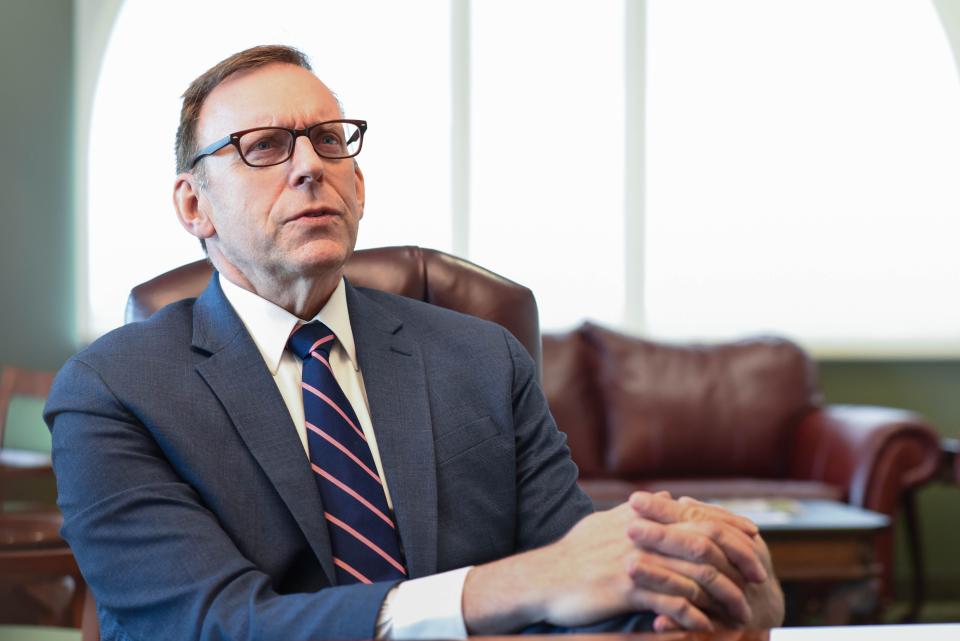Cooley Law School enrollment is at an all-time low. Why officials aren't worried.
LANSING — Enrollment at the Western Michigan University Cooley Law School — once the largest law school in the nation — has fallen below 700 students. But the school’s president isn’t concerned.
Cooley once had multiple campuses and saw enrollment peak at 3,931 students in 2010. But it fell from there for seven straight years. It spiked slightly to 1,358 in 2018, then declined over the course of the COVID-19 pandemic to today's lows. This fall, the school had just 691 between its two campuses in downtown Lansing and Tampa Bay, Florida, according to President James McGrath.
McGrath says reducing enrollment was part of Cooley's plan before the pandemic. The decision was partly financial — when Cooley closed its Grand Rapids campus, it was able to trim overhead and lower tuition. But it's also strategic: In order to retain accreditation, a law school must have 75% of alumni pass the bar exam within 2 years of graduation. For Cooley, a smaller student body is part of a quality-over-quantity approach.
The sweet spot is 800 to 900 students, a benchmark Cooley blew through during the pandemic. The school chose not to admit a new class of students in fall of 2021, since its courses were 100% online.
“We didn’t want to try to recreate the class experience online,” McGrath said. “We wanted to make sure we were doing it right.”

Still, Cooley finds itself in an unfamiliar position with no plans for significant growth. Instead of trying to force a drastic turnaround, leaders are focused on preparing a smaller, more sustainable student body to go on to pass the bar.
“We’re just going to make ourselves the best law school we can be,” McGrath said.
A smaller, more sustainable Cooley
Cooley reached its peak size in 2007. Then the financial the financial crisis hit. The school emerged from the recession in a new job market where there was less demand for new lawyers.
McGrath arrived in July 2019 with goals of increasing enrollment and bar exam pass rates even as Cooley closed campuses. The school closed its Grand Rapids campus last year and merged it with its Lansing campus. It had closed its Auburn Hills campus the year before.
More: New WMU Cooley president looks to raise bar passage rates. With new rules, he'll have to.
The closures came at the beginning of another streak in dropping enrollment. Cooley enrollment fell from 1,358 students in 2018 to 1,228 students in 2019, then to 993 and 691.
Cooley would've seen some security had it become a part of a larger university, McGrath said, but he doesn't believe it's been a significant factor in Cooley's enrollment decline.
Heather Silcott is among Cooley's 691 students and is in her final year. She plans to take the bar exam in February 2023.
Silcott drives to the Lansing campus four days per week from Waterford, where she lives and works as a legal assistant at Progressive Insurance. A law degree will help her pursue a promotion, she said.
Silcott came to Cooley amid intense downsizing. She took her classes at the Auburn Hills campus until it closed, forcing her to switch to the Lansing campus. The commute is worse, but smaller class sizes have helped her build relationships with classmates and professors.
“Everyone is more supportive of you," said Silcott, 27. "Everyone wants you to succeed. Everyone is so welcoming. If you do need extra assistance, someone is there to help you.”
Silcott earned her undergraduate degree in criminal justice at Wayne State University, a larger school where she didn’t know many people despite a student body 40 times larger than Cooley’s.
Now, she’s grown close with several classmates and knows many of her professors on a personal level. It’s not uncommon for students to text professors when they’re struggling in a class, rather than waiting days for an emailed response, she said.
“Every professor I’ve had has been really supportive of each individual student,” Silcott said.
Andrew Abood, a Cooley alumnus and Lansing Community College trustee, believes enrollment isn't an issue so long as Cooley continues to offer a path to a law degree to students who don't otherwise have one.
"I don’t think we should judge a law school by its size or amount of students," he said. "The fact is that Cooley could be very successful as a small school. Its mission is still the same."
Despite the quality of the education Cooley and some alumni boast, success passing the bar exam continues to elude its graduates. The class of 2019 had a two-year bar passage rate of 59.5% while 2018 graduates had a 62.3% rate. That technically means Cooley is out of compliance with American Bar Association standards of a 75% passage rate. However, the ABA gives law schools time and steps to take to return to compliance before yanking accreditation.
McGrath said that while Cooley is out of compliance with the 75% standard, it remains fully accredited and is following ABA rules to return to compliance.
Cooley caters to students that might not otherwise have access to law school, including some who may not take the bar exam directly after graduation. For Silcott, before Cooley, going to law school wasn’t an option, since she needed to keep her full-time job. But Cooley’s night courses made it possible to do both.
McGrath hopes the flexibility of Cooley’s program will draw more students back. So far, it’s helped Cooley diversify its enrollment. In 2019, about 46% of Cooley's enrollment were students of color, with Black students making up approximately 26% of the incoming class.
“We have a mission of access,” he said.
Contact Mark Johnson at (517) 377-1026 or majohnson2@lsj.com. Follow him on Twitter at @ByMarkJohnson.
This article originally appeared on Lansing State Journal: Cooley Law enrollment down as leaders plan for leaner future

